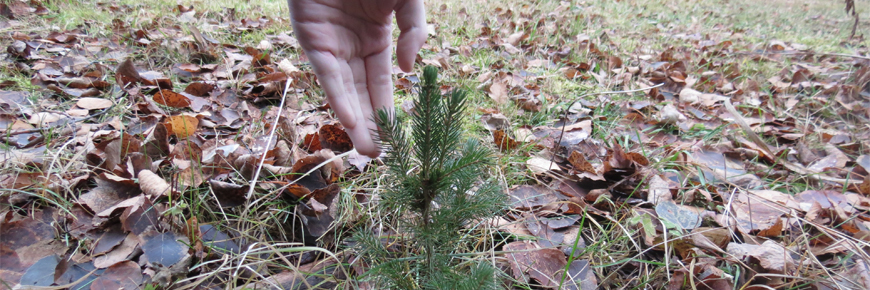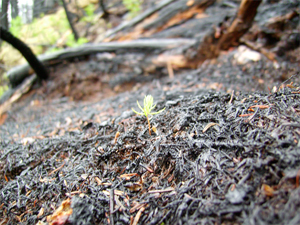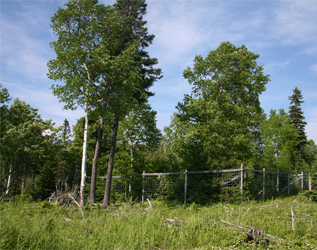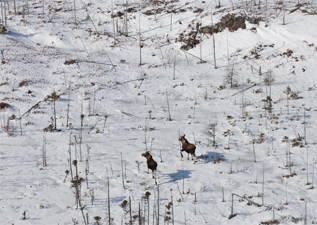
Monitoring
Terra Nova National Park
To ensure park ecosystems are healthy, we need to know how their components and processes are changing over time. This is done through Ecological Integrity (EI) Monitoring.
EI Monitoring provides park managers with critical information on ecosystem health. Over the past century, the forests of Terra Nova National Park have experienced several stressors that have impacted its ecological integrity.
- Fires, a natural forest ecosystem process, have been suppressed thus affecting forest regeneration.
- New species, such as Moose, have been introduced to the island of Newfoundland, causing a shift in native plant and animal populations.
- Through accidental trapping and snaring, as well as habitat loss the native Newfoundland Marten have disappeared from most of the Island, including the forests of Terra Nova National Park.
Documenting change over time allows park managers to guide and assess management decisions in the maintenance and restoration of ecological integrity.

Fire
Fire is a necessary process to allow forest regeneration, and to ensure that native tree species such as black spruce and red pine persist in Terra Nova National Park. Fire encourages regeneration by: opening up the forest canopy and letting light in, releasing seed from cones, renewing the forest floor to allow space for seeds to germinate and grow, and returning essential nutrients to the soil.
Pre- and post- fire monitoring of prescribed fire sites enables park managers to track the essential role of fire in forest regeneration and to ensure our efforts are effective.
Species management- moose

Moose exclosures were established in insect-disturbed areas in 1991. Today, the area inside the exclosures has shown significant growth. The area outside continues to be browsed by moose, preventing balsam fir forests and hardwoods from regenerating.
In a healthy forest, regeneration continually creates trees of various ages- from new seedlings all the way up to mature trees. This variety provides a diversity of habitats, as well as young trees to replace mature trees as they die. The browsing pressure of moose on tree and shrub saplings is measured to determine the severity of impact, as well as the number of trees likely to make it to maturity and replace the forest canopy.

Within randomly selected plots in Terra Nova National Park, balsam fir saplings and hardwoods are counted to determine the proportion that has been browsed. Plots are considered healthy if fewer than 20% of stems found within the plot are browsed. With normal sapling densities, this proportion would allow enough individual trees to escape browsing pressure and replace the forest canopy.
The data found thus far shows that browsing pressure on balsam fir and hardwood trees in Terra Nova National Park is much greater than in a healthy forest.
The majority of the park's balsam fir/mixed hardwood forest stands remain in poor condition due to stress associated mainly with moose browsing. It is hoped that reducing moose numbers will allow more saplings to escape browsing pressure and result in improvements in forest health over the coming years.

Species at risk
Parks Canada staff use "mark-recapture" surveys each year to monitor the population of the Newfoundland Marten. Marten are tagged and released to determine success in re-establishing marten populations in forests in and around Terra Nova National Park.
Protected areas like Terra Nova National Park offer crucial habitat for species at risk. The park is home to several species at risk, including the Newfoundland Marten (Martes americana atrata), the Red Crosbill (Loxia curvirostra percna) and the Boreal Felt Lichen (Erioderma pedicellatum). Through EI monitoring and partnerships with researchers, Parks Canada is able to keep track of how these populations are evolving.

Wildlife cameras
One of the ways that we remotely monitor species in the park is by using wildlife cameras.
In 2018, several large culverts were repaired under the Trans-Canada Highway in Terra Nova National Park. Part of this work was the addition of wildlife crossing structures in the culverts to help small animal species, such as the threatened Newfoundland Marten, cross the highway safely. In order to monitor the effectiveness of these new animal crossings, wildlife cameras were established.
Wildlife cameras are used in Terra Nova National Park for wildlife conservation purposes. Concerned about your privacy? So are we. That's why we delete images of visitors captured on our cameras. However, images that show illegal activities that may have serious impacts on wildlife, or put the safety of visitors at risk may be used for law enforcement purposes.
Related links
- Date modified :